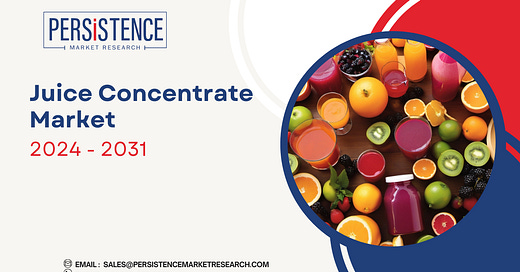The juice concentrates market is witnessing significant growth in North America and Europe, fueled by changing consumer preferences, health trends, and a growing demand for convenience. As health-conscious consumers increasingly seek nutritious beverage options, juice concentrates have emerged as a popular choice in various food and beverage applications. This article explores the factors contributing to the growth of the juice concentrates market in North America and Europe and examines future trends that are likely to shape the industry.
For More Industry Insight: https://www.persistencemarketresearch.com/market-research/juice-concentrates-market.asp
Understanding Juice Concentrates
Juice concentrates are produced by extracting juice from fresh fruits and vegetables and then removing a significant portion of the water content through evaporation. This process results in a concentrated form that retains the essential flavors, vitamins, and minerals of the original produce. Juice concentrates offer several advantages, including longer shelf life, enhanced taste, and versatility, making them an attractive ingredient for manufacturers and consumers alike.
Key Growth Drivers in North America
1. Health and Wellness Trends
One of the primary drivers of growth in the North American juice concentrates market is the rising emphasis on health and wellness. Consumers are increasingly aware of the importance of nutrition and are seeking products that provide health benefits. Juice concentrates, known for their high vitamin and antioxidant content, are becoming popular among health-conscious individuals.
For instance, concentrated fruit juices like orange and apple are rich in vitamins C and A, promoting immune health and overall well-being. The trend towards functional foods—products that provide health benefits beyond basic nutrition—has also spurred interest in juice concentrates. Manufacturers are capitalizing on this demand by introducing products fortified with additional nutrients, making them more appealing to consumers.
2. Convenience and Versatility
The fast-paced lifestyles of consumers in North America are driving the demand for convenient and ready-to-use food and beverage options. Juice concentrates provide a quick and easy way to enjoy the nutritional benefits of fruits and vegetables without the need for extensive preparation.
Manufacturers are increasingly incorporating juice concentrates into a variety of products, including smoothies, energy drinks, and flavored waters. The versatility of juice concentrates allows brands to innovate and create unique flavor combinations that cater to diverse consumer preferences. This adaptability is key to meeting the needs of busy consumers seeking nutritious, on-the-go options.
3. Clean Label Movement
The clean label trend is reshaping consumer expectations in North America, with individuals increasingly scrutinizing product labels for transparency and natural ingredients. Juice concentrates align perfectly with this movement, as they are often made from whole fruits and vegetables without artificial additives or preservatives.
Brands that utilize juice concentrates can market their products as wholesome and natural, resonating with consumers who prioritize clean ingredient lists. This emphasis on transparency helps build trust and loyalty among health-conscious shoppers, further driving demand for juice concentrates in the market.
Key Growth Drivers in Europe
1. Rising Demand for Organic Products
In Europe, there is a notable increase in demand for organic products, driven by consumer awareness of environmental sustainability and health. Juice concentrates derived from organic fruits and vegetables are gaining popularity as consumers seek out products that align with their values.
The European market has seen a significant rise in the availability of organic juice concentrates, catering to consumers looking for natural and sustainably sourced options. This trend is particularly relevant in countries like Germany and the UK, where organic food consumption is well-established. Manufacturers that prioritize organic sourcing will find ample opportunities for growth in this segment.
2. Focus on Sustainable Practices
Sustainability is a major consideration for consumers in Europe, and this is influencing their purchasing decisions. The juice concentrates market is responding to this demand by adopting sustainable practices throughout the supply chain.
Brands are increasingly focusing on responsible sourcing, environmentally friendly production methods, and sustainable packaging solutions. By promoting their commitment to sustainability, juice concentrate manufacturers can appeal to environmentally conscious consumers, further boosting demand in the European market.
3. Innovation in Product Development
The European juice concentrates market is characterized by innovation in product development, with manufacturers constantly exploring new flavors and formulations. The growing trend toward functional beverages is driving the introduction of juice concentrates that offer added health benefits, such as probiotics, vitamins, and minerals.
Additionally, European consumers are becoming more adventurous in their tastes, seeking unique and exotic flavors. Juice concentrates made from tropical fruits or superfoods are gaining traction as brands experiment with innovative combinations to attract health-focused consumers.
Future Outlook for the Juice Concentrates Market
The juice concentrates market in North America and Europe is expected to continue its growth trajectory in the coming years. Several trends are likely to shape the industry:
1. Increased Focus on Health and Wellness
As health and wellness continue to be a priority for consumers, the demand for juice concentrates that offer functional benefits will likely rise. Manufacturers will need to innovate and develop products that align with emerging health trends, such as gut health, immunity, and overall well-being.
2. Expansion in E-Commerce
The rise of e-commerce is transforming the way consumers shop for beverages and food products. Online platforms provide greater access to a variety of juice concentrates, allowing consumers to explore different brands and flavors. Manufacturers that invest in e-commerce strategies and direct-to-consumer models will benefit from this trend.
3. Continued Emphasis on Sustainability
Sustainability will remain a key focus for consumers in both North America and Europe. Brands that prioritize eco-friendly sourcing, production, and packaging will be well-positioned to capture the attention of environmentally conscious consumers. This emphasis on sustainability will drive innovation in the juice concentrates market.




